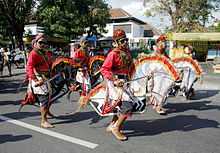Kuda Lumping
 Kuda Lumping dance during a festival in Yogyakarta | |
| Genre | Traditional |
|---|---|
| Country | Indonesia |
Kuda Lumping (literally flat horse; also known as Jaran Kepang in Javanese) is a traditional Javanese dance depicting a group of horsemen. Dancers "ride" horses made from woven bamboo and decorated with colorful paints and cloth. Generally, the dance portrays troops riding horses, but another type of Kuda Lumping performance also incorporates trances and magic tricks. When the "possessed" dancer is performing the dance in trance conditions, he can display unusual abilities, such as eating glass and resistance to the effects of whipping or hot coals. Although the dance is native to Java, Indonesia, it also performed by Javanese communities in Suriname, Malaysia and Singapore.
Origin
The origin of Kuda Lumping is uncertain. Two main hypotheses have been proposed. The first suggests that Kuda Lumping may have arisen out of Diponegoro's war against the Dutch colonial forces, as a ritual reenactment of battles. The second argues that it is based on Mataram-era troops riding against the Dutch.[1]
Kuda Lumping is known under different names in different areas. While Kuda Lumping is the most common name in West Java, in Central Java it is known as Jaran Kepang; in Bali, it is known as Sang Hyang Jaran.[2] In Bali Sanghyang dance refer to the type of dance involving trance by spirit identified as hyang.
Performance
Kuda Lumping may be performed in celebration of a special event, such as a boy's circumcision or rite of passage.[3] It may also be performed as entertainment, in a busker style.[1] It is generally performed in a cordoned-off area, with the audience separated from the dancers.[4]
Kuda Lumping is traditionally performed by a group of men drawn from the local community; this group can number from 2 to 8.[2][5][6] The performers mount rattan horses and dance while traditional instruments such as the angklung, gongs, and dog-dog drums are played.[1][4][5] This portion of the performance ends when a dancer enters a trance, which is traditionally said to be caused by spirit possession.[1] In Sang Hyang Jaran, the audience may participate by forming a chorus and singing.[2]
During their trances, the dancers may pretend to eat grass or drink water, while another performer or shaman uses a whip to direct them. In some performances, dancers may walk on coals or eat glass or fire, which can cause various injuries. The dancers also interact with the audience; in busker performances they may ask for money. In some areas the dancers serve as oracles to deliver prophecies. After awakening from their trances, performers claim not to remember anything done while performing.[1][2]
Equipment

Dancers perform using rattan horses, generally colourful and decorated with beads and sequins. Adults use larger horses than children. Children's horses may also be cut from bamboo mats.[7] Performers wear colorful clothes and may occasionally dress as soldiers. The costume may also include small bells strung around the ankle.[1] In comparison to the shaman, the dancers' costumes are more feminized.[8]
Symbolism
Henry Spiller suggests that Kuda Lumping represents spiritual power and masculine virility, which is "wild and uncontrolled ... yet ultimately a good thing".[9] Max Richter notes that the erratic movements of the "feminized" dancers may "draw on ideas about the subordinate 'irrational' female", while the slower, more deliberate movements of the shaman "may be seen as masculine and potent". However, he considers this secondary to the conflicts of science versus magic, and good versus bad.[8] He also notes that it serves as a way for young boys to release energy in a non-violent manner.[10]
Reception
Kuda Lumping is widely popular. But, individual observer opinions vary. Some view it as being related to Satan and thus evil, while others see it as being a good influence. A shift in meaning, from a mainly spiritual ritual to entertainment, has been noted.[11]
Kuda Lumping has been used as the basis for a dangdut song of the same name.[5]
References
- Footnotes
- ↑ 1.0 1.1 1.2 1.3 1.4 1.5 Mardiyati, Ade (16 March 2010). "Kuda Lumping: A Spirited, Glass-Eating Javanese Game of Horse". The Jakarta Globe. Retrieved 31 July 2011.
- ↑ 2.0 2.1 2.2 2.3 Bandem 2008, p. 2
- ↑ Hellman 2003, p. 16
- ↑ 4.0 4.1 Richter 2008, p. 170
- ↑ 5.0 5.1 5.2 Spiller 2008, p. 199
- ↑ Richter 2008, p. 170
- ↑ Epstein 2008, p. 219
- ↑ 8.0 8.1 Richter 2008, p. 172
- ↑ Spiller 2008, p. 200
- ↑ Richter 2008, p. 171
- ↑ Richter 2008, p. 171
- Bibliography
- Bandem, I Made (2008). "Performing Arts of Indonesia (Performance Education and Archive)". Wesleyan University. Retrieved 31 July 2011.
- Epstein, Irving (2008). The Greenwood Encyclopedia of Children's Issues Worldwide. Volume 1. Westport, Connecticut: Greenwood Press. ISBN 978-0-313-33620-1.
- Hellman, Jörgen (2003). Performing the Nation: Cultural Politics in New Order Indonesia. Copenhagen: NIAS Press. ISBN 978-0-7007-1678-4.
- Richter, Max (2008). "Other Worlds in Yogyakarta: From Jatilan to Electronic Music". In Ariel Heryanto. Popular Culture in Indonesia : Fluid Identities in Post-Authoritarian Politics. London: Routledge. pp. 164–181. ISBN 978-0-415-46112-2.
- Spiller, Henry (2008). Focus : Gamelan Music of Indonesia. New York: Routledge. ISBN 978-0-203-93099-1.
